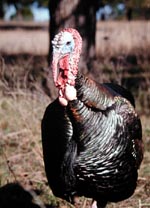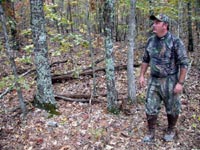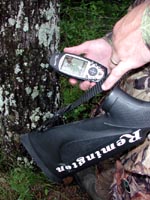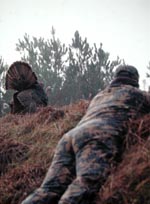
|
Features
|
|
|
|
Books
|
|
|
|
Fun & Games
|
|
|
|
Contact Us
|
|
|
John's Journal... Entry 241, Day 1
SPACE-AGE GOBBLERS WITH DON TAYLOR
GPSing Albert
 Editor's
Note: Global Positioning Systems (GPS) is a system of satellites that
circle the earth and give off signals. Each GPS satellite transmits its
precise location (position and elevation) and the start time of the transmission.
A GPS receiver acquires the signal and then measures the interval between
transmission and receipt of the signal to determine the distance between
the receiver and the satellite-a process called ranging. Once the receiver
has computed range for at least three satellites, the receiver's location
on the surface of the earth can be determined.
Editor's
Note: Global Positioning Systems (GPS) is a system of satellites that
circle the earth and give off signals. Each GPS satellite transmits its
precise location (position and elevation) and the start time of the transmission.
A GPS receiver acquires the signal and then measures the interval between
transmission and receipt of the signal to determine the distance between
the receiver and the satellite-a process called ranging. Once the receiver
has computed range for at least three satellites, the receiver's location
on the surface of the earth can be determined.
Each satellite transmits two types of data, almanac and ephemeris. Almanac data, general information on the location and health of each satellite on the constellation, can be collected from any satellite. A receiver with a current almanac in its memory knows where in the sky to look for satellites, given its last known position and the time of day. Ephemeris data is the precise satellite positioning information that is used for ranging. Each satellite transmits its own ephemeris data. Both almanac and ephemeris data are required for a GPS receiver to locate and acquire satellites quickly and compute your position. GPS produces accuracies of about 27 yards or better, bringing you within visual range of a destination or a target. Most GPS receivers allow you to log waypoints, either by number or name, which remain in its memory until you either delete it or change it. Regardless of your distance from a waypoint, the computer can calculate the direction you need to travel and the distance from it. This week, Don Taylor, a longtime turkey hunter from Alabama, shares the experiences he's had hunting with his GPS receiver.
 As
I sloshed through the inky black water of the swamp late in the afternoon,
I laid an invisible trail marked only by satellites in outer space and
my GPS hand-held receiver. I would follow that trail the next morning
before daylight to reach my stand site to hunt Albert. Every morning this
gobbler Albert pitched off the limb where he roosted over flooded timber
and flew to a small island about 80 yards out in the water. I had no way
to approach the island during daylight hours without the gobbler spotting
me. I sometimes watched him strutting on the island that was too far away
for me to shoot.
As
I sloshed through the inky black water of the swamp late in the afternoon,
I laid an invisible trail marked only by satellites in outer space and
my GPS hand-held receiver. I would follow that trail the next morning
before daylight to reach my stand site to hunt Albert. Every morning this
gobbler Albert pitched off the limb where he roosted over flooded timber
and flew to a small island about 80 yards out in the water. I had no way
to approach the island during daylight hours without the gobbler spotting
me. I sometimes watched him strutting on the island that was too far away
for me to shoot.
 On
this afternoon, I'd waded through the swamp in knee-deep water for 1/2-mile
and picked a stand site where I could set up without spooking Albert.
I used my hand-held GPS receiver to get a fix on my position. I hit the
button to mark this location as a waypoint. Then I punched the 'Mark A
Trail' button and pulled up the waypoint I had entered earlier where I'd
left my vehicle. While I walked from the island through the water back
to my vehicle, my GPS charted the course I took. When I arrived at my
car, I pushed the 'Save Trail' button and stored my route in the memory
of the receiver. The following morning with no moon to light my path,
I set out with my GPS receiver to find my turkey-hunting blind through
the dark water. Arriving at my destination in less than 45 minutes, I
waited for the coming of daylight and Albert. He gobbled before first
light. Because I knew this smart bird had whipped several other members
of my hunting club, I didn't want to over-call. I cupped my hand and threw
my call away from the island to some trees in the flooded timber and gave
a soft tree call. Albert screamed back.
On
this afternoon, I'd waded through the swamp in knee-deep water for 1/2-mile
and picked a stand site where I could set up without spooking Albert.
I used my hand-held GPS receiver to get a fix on my position. I hit the
button to mark this location as a waypoint. Then I punched the 'Mark A
Trail' button and pulled up the waypoint I had entered earlier where I'd
left my vehicle. While I walked from the island through the water back
to my vehicle, my GPS charted the course I took. When I arrived at my
car, I pushed the 'Save Trail' button and stored my route in the memory
of the receiver. The following morning with no moon to light my path,
I set out with my GPS receiver to find my turkey-hunting blind through
the dark water. Arriving at my destination in less than 45 minutes, I
waited for the coming of daylight and Albert. He gobbled before first
light. Because I knew this smart bird had whipped several other members
of my hunting club, I didn't want to over-call. I cupped my hand and threw
my call away from the island to some trees in the flooded timber and gave
a soft tree call. Albert screamed back.
 Next
I gave a fly-down cackle and beat my pants leg with my gloved hand to
sound like a turkey flying down and landing on the island. Albert double
gobbled. After giving some soft clucks and yelps, I waited before scratching
in the leaves to sound like a feeding hen. I didn't call any more. After
10 minutes of listening to Albert gobble with almost every breath, I heard
the beating of wings. In less than three heartbeats, Albert landed about
20 yards from my stand. I released a load of No. 5s, collected my prize
and reached in my pocket for my GPS receiver. This space-age device that
had led me straight to the tom I'd hunted for two years now would direct
me back to my vehicle. The GPS receiver solves many problems for the turkey
hunter. You'll never be lost, and you can accurately navigate to and from
any position in the woods during the day or night.
Next
I gave a fly-down cackle and beat my pants leg with my gloved hand to
sound like a turkey flying down and landing on the island. Albert double
gobbled. After giving some soft clucks and yelps, I waited before scratching
in the leaves to sound like a feeding hen. I didn't call any more. After
10 minutes of listening to Albert gobble with almost every breath, I heard
the beating of wings. In less than three heartbeats, Albert landed about
20 yards from my stand. I released a load of No. 5s, collected my prize
and reached in my pocket for my GPS receiver. This space-age device that
had led me straight to the tom I'd hunted for two years now would direct
me back to my vehicle. The GPS receiver solves many problems for the turkey
hunter. You'll never be lost, and you can accurately navigate to and from
any position in the woods during the day or night.
TOMORROW: BE LOST NO MORE
Check back each day this week for more about SPACE-AGE GOBBLERS WITH DON TAYLOR ...
Day 1 - GPSing Albert
Day 2 - Be Lost No More
Day 3 - Hunt Non-Pressured Gobblers And Create
A Hunting Plan Using Your GPS
Day 4 - The Slue-Foot Gobbler
Day 5 - Give A Turkey To A Friend